Services on Demand
Journal
Article
Indicators
-
 Cited by SciELO
Cited by SciELO -
 Access statistics
Access statistics
Related links
-
 Similars in
SciELO
Similars in
SciELO
Share
Revista mexicana de fitopatología
On-line version ISSN 2007-8080Print version ISSN 0185-3309
Rev. mex. fitopatol vol.32 n.2 Texcoco 2014
Review articles
Effect of initial disease intensity of cactus black spot (Opuntia ficus-indica) in the temporal and spatial characterization
3 Parasitología Agrícola. Universidad Autónoma Chapingo. Km 36.5 Carretera México-Texcoco. Chapingo, México. C.P. 56230.
4 Entomología y Acarología. Campus Montecillo, Colegio de Posgraduados. Km. 36.5 Carretera México-Texcoco, Montecillo, México. C.P. 56230.
Black spot caused by Pseudocercospora opuntiae is a major nopal fungus disease in Tlalnepantla, Morelos. The objective of this research was to characterize the temporal and spatial progress of the disease and evaluate the efficacy of six systemic fungicides. The epidemics intensity in the autum did not depend on the initial disease severity (r2=0.49), which suggested the occurrence of a major infection cycle in the summer. Final incidence (Yf ) of the disease ranged from 85 to 88 %. From 20.9 to 52.3 % cladodes per plant were damaged and from 37 to 56.4 % plants showed severity levels higher than 20 %. It started with 46 % initial severity (Yo ) and developed to a higher epidemic intensity (Yf = 90.5 spots and ABCPE = 8.6 number of spots per day-1), which led to the development of 3.1 spots per day-1 in a 29-day period. However, this severity level was statistically similar to the type of epidemics induced by Yo =20.7 y 73.5 % (p=0.05). Low relative humidity (<60 %) was associated with a large stage of new lesions. High relative humidity (>80 %) was associated with a short period for the spot to mature. Minimum temperature had a similar association with values from 8 to 12 °C and lower values for the same events. Changes in the expression of symptoms defined the epidemics speed. Aggregate formation was detected through geostatistical interpolation and aggregation indexes (I. Morisita from 1.6 to 1.9) in direction to rows and border effect, which suggested the effect of agronomic management of disease spreading.
Two benzimidazoles achieved the highest biological efficacy against fungus reducing ABCPE by 85.7 % in average compared to the tester (p=0.05). These systemic fungicides are an option to reduce epidemic expression in autum caused by infections in summer.
Key words: Pseudocercospora sp; epidemiology; fungicides
La mancha negra, causada por Pseudocercospora opuntiae, es la principal enfermedad fungosa del nopal verdura en Tlalnepantla, Morelos. El objetivo de este trabajo fue caracterizar el progreso espacio-temporal de la enfermedad y evaluar la efectividad de seis fungicidas sistémicos. La intensidad epidémica de otoño no fue dependiente del nivel de severidad inicial (r2=0.49), lo que sugiere la ocurrencia de un ciclo principal de infección en verano. La incidencia final (Yf) de la enfermedad varió de 85 y 88 %. Entre 20.9 y 52.3 % de los cladodios por planta resultaron dañados y del 37 al 56.4 % de las plantas presentaron una severidad mayor al 20 %. Con severidad inicial (Yo ) de 46 %, se originó la mayor intensidad epidémica (Yf = 90.5 manchas y ABCPE = 8.6 número manchas día-1), lo que implicó el desarrollo en 29 días de 3.1 manchas día-1. Sin embargo, este nivel de severidad fue estadísticamente similar al tipo de epidemias inducidas por Yo =20.7 y 73.5 % (p=0.05). La humedad relativa baja (<60 %) estuvo asociada con un largo estadio de las lesiones nuevas. La alta (>80 %) se asoció con un periodo corto para alcanzar una mancha madura. La temperatura mínima tuvo similar asociación con valores de 8 a 12 °C e inferiores a 8 °C para los mismos eventos. Los cambios en la expresión de síntomas determinaron la velocidad de epidemia. Mediante interpolación geoestadística e índices de agregación (I. Morisita de 1.6 a 1.9) se detectó la formación de agregados con dirección a los surcos y efecto de orilla, indicativa del efecto de manejo agronómico en la dispersión de la enfermedad. Dos benzimidazoles tuvieron la mayor efectividad biológica contra el hongo reduciendo en promedio 85.7 % del ABCPE con respecto al testigo (p=0.05). Estos fungicidas sistémicos constituyen una opción para reducir en otoño la expresión epidémica derivada de infecciones en verano.
Palabras clave: Pseudocercospora sp; epidemiología; fungicidas
INTRODUCTION
Nopal black spot caused by Pseudocerospora Opuntiae (Ayala-Escobar et al., 2006; Quezada-Salinas et al., 2006), cactus weevil (Metamasius spinolae) and cactus cochineal (Dactylopius coccus) are the three main phytosanitary problems of edible nopal in the state of Morelos (GIIN, 20056). In this region, these problems have been addressed as an integral part of the nopal production chain (Rodríguez-Leyva et al., 2008). P. opuntiae fungus is a complex problem possibly due to its interaction with other plant pathogens and plant nutrition (Quezada-Salinas et al., 2006; Rodríguez-Leyva et al., 2008). A key aspect of disease management is the knowledge of infections and/or latent inoculum in plants given the perennial nature of the infected tissue and intensive tissue removal by pruning and leaving residues on the soil surface. The objective of this research was to define the spatial-temporal progress of nopal black spot in relation to initial damage levels and define its effect on the epidemic intensity, critical or infection stages, and optimize fungicide management.
MATERIALS AND METHODS
Temporal progress
Based on previous outputs regarding the period of higher regional disease intensity and occurrence (GIIN, 2005), in autum 2006 three plots were selected (P1-P3) in the area of higher incidence of black spot in Tlalnepantla, Morelos (2135-2242 masl) Also, eight commercial plots distributed across the area were randomly selected. 4-6 years old farms corresponded to the Milpa Alta edible nopal type. To estimate the effect of the initial inoculum on the temporal epidemic progress, three cladodes corresponding to each of the six types of severity, according to the scale used, were selected for a total of 18 cladodes in as many plants distributed in three blocks in P1. Each type of severity showed the initial condition of the disease (Yo ). These plants were not chemically treated to control black spot. Starting 11 November, the number of new, fresh and old spots was counted on a weekly basis. Analysis were conducted by plants block and combined. In the eight randomly selected plots 100 plants were evaluated to detect the presence or absence of the disease on 20 July and 7 October, 2006, and 19 January, 2007.
Furthermore, 39 randomly selected cladodes were marked in P1. A digital picture was taken (1920x2560dpi) weekly using a length scale to record cladodes and lesion dimensions. The analysis of 195 images allowed studying the development of spots regarding time, color and consistency. Cladodes growing speed was studied from leaf bud to harvest size to link cladode maturity with symptom expression. As of October, two temperature and relative humidity sensors were placed (Hobo Data Loggers To/Hr). The analysis included calculations of the initial (Yo) and final (Yf ) disease intensity and of the area underneath the disease progress curve (ABCPE) using SAS programming (1988) and t tests.
Spatial progress
For the spatial study, a census of 20 rows x 20 plants/row was taken to evaluate disease severity with a logharitmic diagrammatic scale (Rodríguez-Leyva et al., 2008). The evaluation was conducted using mature cladodes from plant medium or top stratums. The total number of old, fresh and new cladodes spots was counted in 12 plants per plot, as well as the number of cladodes with at least one type of spot. Spot typology was defined by lesion color and consistency. Data analysis included geostatistical interpolative maps made in Surfer® ver. 6.04; the Morisita aggregation index was calculated using MorLloyd ver. 1.0, a program developed in MS Excel® (Rivas and Mora-Aguilera, 20087).
System fungicide efficacy tests
Due to the process of summer infection, systemic fungicides were evaluated to reduce the epidemic expression in autum (Table 1). Efficacy tests against P. opuntiae were conducted from October 2006 to January 2007 in plot P1. Six systematic fungicides from chemical groups with different action mechanism were evaluated. The first application was made using a hand pump (SOLO® 15L) on 28 October, and the second application was made 21 days later. The products were prepared in situ adding a comercial pH regulator (Dap-Plus® 1mL/L of water). The number of new, fresh and old cladodes spots with initial damage corresponding to each type of severity according to the scale used was recorded. The design of treatments was a completely randomized factorial 6x2 with three nested replications. Each replication consisted of a 40-plant row. Fungicide efficacy was evaluated using ABCPE (Mora-Aguilera and Rivas, 2001). The median comparison was made using Duncan to p=0.05. All the analysis were conducted using SAS (1988).
RESULTS AND DISCUSSION
Temporal progress
Black spot incidence was regionally and seasonably variable (Figure 1). Overall, there was a lower incidence in summer (3.6 % average) and a higher incidence in winter (22.5 %). In plot 1, the epidemics intensity did not correspond to the disease initial damage at cladode level. The cumulative increase of the disease, which was estimated by the number of active spots (fresh and new) was higher at initial severity level 46 % (Yo) and ranked at level five of the severity scale used (Figure 2). To this level Yf and ABCPE showed values of 90.5 spots and 8.6 number of spots per day-1, respectively, which suggested the development of 3.1 spots per day-1 in a 29-day period. With 0 % initial levels there was no epidemic progress. When Yo was lower than 7.4 the epidemics intensity was low (Yf =27, ABCPE=2.9) (Figure 2), which suggests temporal processes that depend on inoculum increases through several crop production cycles due to the perennial characteristics of cladodes. For Y o=73.5 %, the epidemic progress was lower than the epidemics progress induced by Y o=46 %, though no statistical differences were reported (Figure 2). To this damage level, less than 25 % tissue was available for new infections due to tissue loss caused by old lesions (Figure 3).
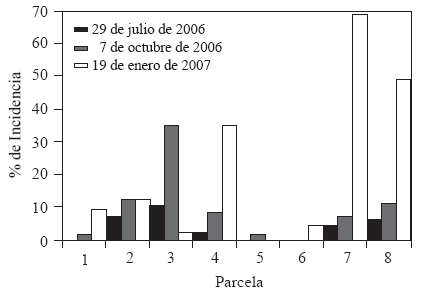
Figure 1 Black spot incidence in eight edible nopal commercial plots in three sampling dates. Tlalnepantla, Morelos. 2006-2007.
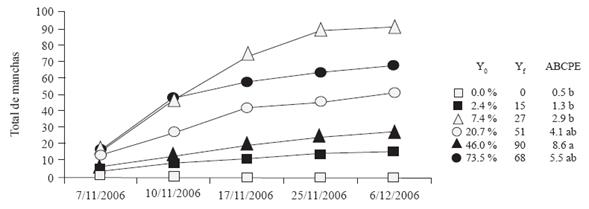
Figura 2 Temporal progress of edible nopal black spots at different levels of initial severity (Yo ). ABCPE with at least one letter in common are statistically equal (Duncan, p=0.05). Tlalnepantla, Morelos. Autum, 2006.
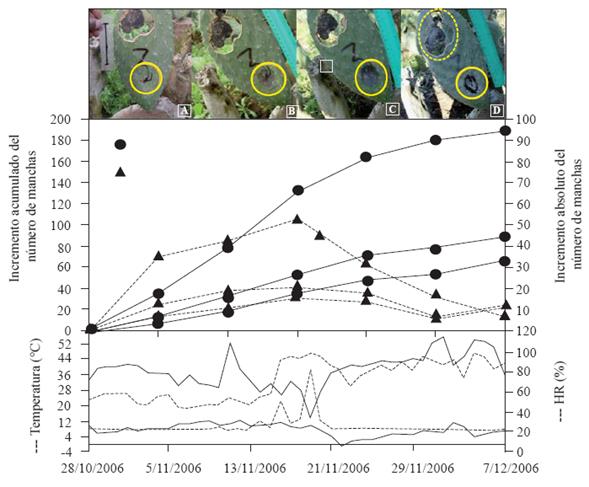
Figure 3 Lesion development and temporal progress curves of edible nopal black spots. A and B=new spot, C=fresh spot, and D=old spot with and without tissue loss, solid and dotted circle, respectively. Tlalnepantla, Morelos. Autum 2006.
The epidemic progress, estimated by the number of fresh spots and by combining the six initial severity levels, had a maximum cummulative of 187 spots at 40 days of epidemics. This suggests a low inoculum efficiency and/or reduced density of the inoculum in the air. However, damage was significant because of the lesion expansion, which in some cases caused cladodes to fold and loss of damaged tissue. Tissue removal may be a resistance mechanism to compensate the succulent consistency of the plant. Epidemic progress was associated with an average minimum temperature of 6.8 °C and relative humidity between 50 and 100 % (Figure 3). In the lower areas of the region, there was no epidemics development; average minimum temperature was 11.1 °C and relative humidity between 24 and 88.6 % (Hernández-Sánchez, 20088). Given the fungus incubation period ranging from 90 to 104 days (Quezada-Salinas et al., 2006; GIIN. 2008. Unpublished data) and the length of epidemics (40 days), it is stated that, firstly, the initial level of damage (Yo) did not have any direct correlation with the epidemics intensity, as it has been proven with other multiple-cycle and concurrent infection pathosystems during an epidemics process (Campbell and Madden, 1990). For this reason, initial damage levels higher than 73 % were not associated with higher-intensity epidemics. Secondly, the epidemics structure may be defined by the speed at which symptoms appear, which explains the absence of a typical curve (for example, logistic, exponential, monomolecular). Therefore, the period from 10-25 November, associated with the higher absolute increase of the disease (Figure 3) actually corresponded to an estimated main infection period in summer between 26 July and 25 August. In the past, the apparent concurrency of a sportulation peak at the end of July and early August (Quezada-Salinas, 2005. Unpublished data) has been proven. At regional level, disease incidence was low in summer, while in autum and early winter a high incidence was observed, which supports the second statement (Figure 1). A seconday infection cycle may take place in autum with epidemics expression of low intensity at the end of winter (Yf =1.8-4 % to 14 March) (GIIN, 2008. Unpublished data). At this stage, there was a remarkable decrease in relative humidity (from 90 to 40 %). This condition induces latent infections as another pathogenic induction mechanism besides aerial spores.
Regarding the speed at which symptoms appear (Figure 3) a period from 8 to 14 days was required for a 2-4 cm semicircular fresh lesion to form. The lesion was dark brown to black, of soft consistency and slightly sunken. It was formed from a new lesion, typified by a circular and chlorotic spot of around 1 cm diameter. Old lesions were formed between 24-30 and 14-22 days following the new and fresh spots, respectively. In this case, lessions can coalesce and form black and dry irregular spots that can be released leaving voids in the cladode (Figure 3). Some signs of black granulated appearance, possibly of stromatic type (Ayala-Escobar et al., 2006), putative to P. opuntiae, appeared during the final phase of fresh lesions.
Low relative humidity (<60 %) was associated with a long new lesions stage. In contrast, high relative humidity (>80 %) was associated with a shorter period for the spot to age. Minimum temperature had similar association with values from 8 to 12 °C and lower than 8 °C for the same events (Figure 3). For this reason, high and low temperatures may be important for spots to mature and fungus structures production. This can explain the disease endemic presence in areas with altitude ranging from 2135 to 2600 masl, including Tlalnepantla, Morelos, intermediate and high areas (Hernández-Sánchez, 20087).
Cladodes growth period was of around 45 days, less time than the time required for black spot incubation (Quezada-Salinas et al., 2006), so because of scape and/or inhibitory substances, no symptoms in the field were observed.
Spatial progress
Diseased cladodes incidence per plant fluctuated between 20.9 and 52.3 % (P1-P3). The average number of spots per cladode ranged from 4.1 to 7.0, while the number of cladodes per plant ranged between 7.9 and 12.5 (Figure 4). In these plots, between 37 and 56.4 % from all the plants showed severity levels higher than 20 %, and only between 12 and 16 % plants were healthy (Figure 5). These outputs suggest high levels of epidemic intensity induced by P. opuntiae, which was measured through changes of incidence and severity of active infection spots (new and fresh).

Figure 4 Incidence and severity of edible nopal black spot in three comercial plots (P1-P3) in Tlalnepantla, Morelos. CLA/PTA= Number of cladodes per plant; MAN/CLA = Total spots per cladode (Severity); %CLA DAÑ = Cladodes percentage with some type of damage (Incidence).
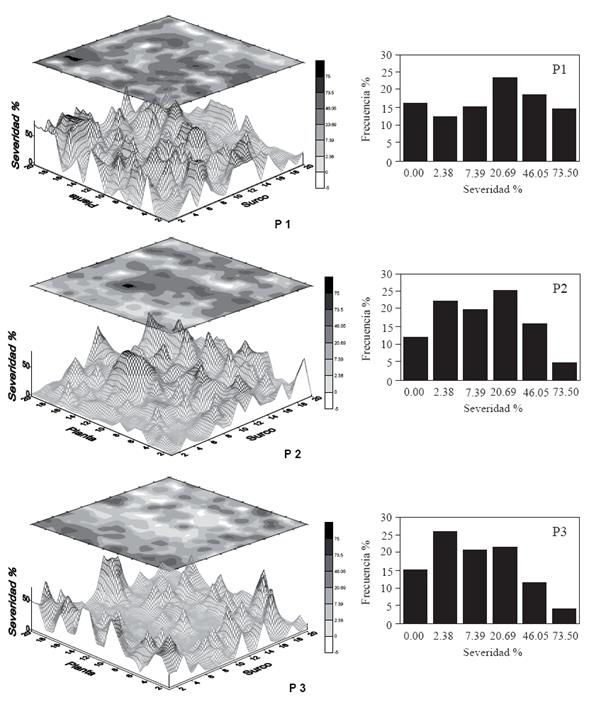
Figure 5 Interpolative geostatistical maps of spreading and severity frecuency of black spot in three edible nopal commercial plots. Tlalnepantla, Morelos. Autum 2006.
Black spot formed aggregates in direction to rows. There was also an apparent border effect attributed to inoculum from neighboring plots (Figure 5). Despite the permanent characteristic of tissue lessions, no uniform disease distribution was detected, which may suggest that the pathogen spreading is influenced by crop management, possibly by plant pruning with disinfected tools and prune residues left in the field. Due to productive induction and sanitation (Rodríguez-Leyva et al., 2008), the intensity of nopal pruning is higher in autum and winter, respectively, after the fungus higher epidemic activity phase, which results in a significant number of infected cladodes.
Although the disease incidence had a similar performance in the three plots in the range of the studied altitudes (2135-2242 masl), severity varied and was directly proportional to the altitude (r=0.99)(Figure 4). These outputs confirm that the epidemic induction of the disease, attributed to weather factors (Figure 3), particularly to low temperature (minimum average 5 °C), contributes to damage intensity and that production areas at altitudes higher than 2135 masl are more vulnerable. This must be considered for long-term precision phytosanitary management.
Systemic fungicides efficacy tests
Using systemic fungicides resulted in a reduction of fungus infection with different levels of efficacy (Figure 6). Two benzimidazoles (T4 and T5) reduced ABCPE by 88.9 % and 82.6 % compared to the tester (T13), and, in average, this group (T4, T5 and T6) showed a significant reduction by 80.8 % (p=0.05). Triazoles and strobirulins had a less consistent performance. The average reduction was 57.6 % for the same variable. High doses (T2) of azoxistrobin (strobirulin) reduced by 85.4 % the disease severity compared to the tester. However, the performance of treatments T8 (strobirulin) and T12 (triazol) was similar to the performance of the tester with reductions of 27.8 and 32.6 %, respectively (p=0.05) (Figure 6). T1 and T3 were not analyzed for they were located in a high severity area, which caused cladodes loss.
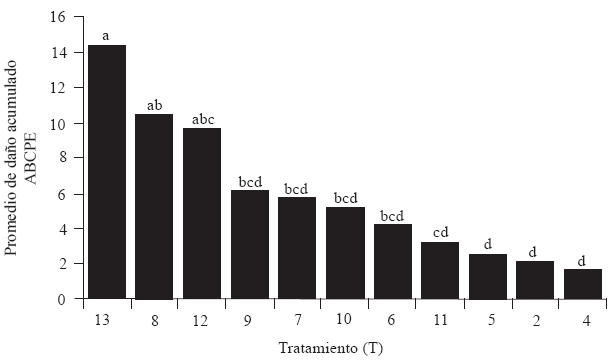
Figura 6 Effect of six systemic fungicides in two doses in the Average of the Area under the Disease Progress Curve (ABCPE) of edible nopal black spot.
Althoug fungicides T4 and T5 (benzimidazoles) and T2 (strobirulin) were the most effective, they must be validated before submitting a regional recommendation. The hydrophobic nature of the waxy cover of cladodes hindered fungicide dispersion and penetration, so the addition of adjuvants should be evaluated, as well as the proper time for application given their photsyntetic metabolism. Also, it is necessary to assess their integration into crop practices such as removal of pruning residues. On the other hand, regarding the potential use of Bemomy (T4), it is recommended to conduct a review of resistance based on application experiences in the region (GIIN, 20051). Development of resistance to this group has been reported for other fungi in different crops (Arias and Carrizales, 2007; FRAC, 2007). A chemical control scheme must include contact fungicides application to reduce Yo, derived from the first infection cyle in summer, and systemic fungicides to reduce epidemic expression in autum.
CONCLUSIONS
In Tlalnepantla, Morelos, the edible nopal black spot epidemics induced by Pseudocercospora opuntiae depended on an infection major process in summer, so the initial severity level (Yo) in autum was not correlated to the epidemics intensity. This depended on the number of infections in summer and of the speed of symptoms expression. For a 46 % initial damage, the epidemics expression in autum lasted 40 days, with Yf = 90 fresh spots and ABCPE= 8.6 number of spots per day-1. This represents 3.1 spots per day-1. The maximum lesion development depended on relative humidity over 80 % and minimum temperatures between 8 and 12 °C. The disease developed in the form of different intensity aggregates because of local agronomic management and sanitary conditions. Two benzimidales achieved a better biological efficacy against the fungus reducing ABCPE by 85.4 % compared to the tester (p=0.05). Systemic fungicides are an option to reduce epidemics expression in autum.
Acknowledgements
To COMUNOTLA and farmers Erick Torres Espín and Hermenegildo Alvarado González for their support to GIIN. To Fundación Produce Morelos A.C., CESVMOR, the Municipal Government of Tlalnepantla and CONACYT for funding this project.
REFERENCES
Arias, R., B. y L. Carrizales. 2007. Control químico de la antracnosis del mango (Mangifera indica L.) en pre y poscosecha en el municipio Cedeño, estado Monagas, Venezuela. Bioagro 19(1): 19-25. [ Links ]
Ayala-Escobar, V., M. de J. Yañez-Morales, U. Braun, Z. Groenewald J., and W. P. Crous. 2006. Pseudocerscospora opuntiae sp. nov., the causal organism of cactus leaf spot in Mexico. Fungal Diversity 21:1-9. [ Links ]
Campbell, C. L., and L. V. Madden. 1990. Introduction to Plant Disease Epidemiology. John Wiley & Sons. New York. 532 p. [ Links ]
FRAC (Fungicide Resistance Action Committee). 2007. Mode of Action of Fungicides. FRAC classification on mode of action 2007 ( FRAC classification on mode of action 2007 (http://www.frac.info ). Fecha de consulta agosto 2008. [ Links ]
GIIN (Grupo Interdisciplinario de Investigación del Nopal). 2005. Diagnóstico Fitosanitario del Nopal Verdura (Opuntia ficus-indica) en Tlalnepantla, Morelos. 85 p. Colegio de Postgraduados. [ Links ]
Hernández-Sánchez, E. 2008. Epidemiología y control del agente causal de la mancha negra (Pseudocercospora opuntiae) en nopal verdura (Opuntia ficus-indica) Tesis MC. Colegio de Postgraduados. 120p. [ Links ]
Mora-Aguilera, G. y P. Rivas. 2001. Análisis estadístico de estudios de efectividad biológica de plaguicidas. Bases para realizar estudios de efectividad biológica de plaguicidas. Bautista, M. N. y Díaz, G. O. (Eds.) Instituto de Fitosanidad, Colegio de Posgraduados. Pp. 1-28. [ Links ]
Quezada-Salinas, A., J.S. Sandoval-Islas, D. Alvarado-Rosales y E. Cárdenas-Soriano. 2006. Etiología de la mancha negra del nopal (Opuntia ficus-indica Mill) en Tlalnepantla, Morelos, México. Agrociencia 40: 641-653. [ Links ]
Rivas, V. y G. Mora-Aguilera, 2008. MorLloyd ver 1.0 MS.Excel. Colegio de Postgraduados. Montecillos México (No Publicado). [ Links ]
Rodríguez-Leyva, E., J. R. Lomeli-Flores, y A. López-Jiménez (Eds.) 2008. Cadena Productiva del Nopal Verdura: II Taller de avances de investigación del Grupo Interdisciplinario de Investigación del Nopal (GIIN). Colegio de Post-graduados. Campus Montecillo, Texcoco, México. 69 pp. [ Links ]
SAS Institute. 1988. SAS User's Guide: Statistics. Release 6.03 Edition. SAS Institute, Inc. Cary, N.C. USA. 1028 p. [ Links ]
Received: December 01, 2014; Accepted: January 27, 2016











 text in
text in 



